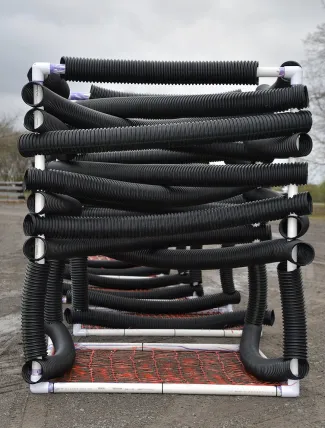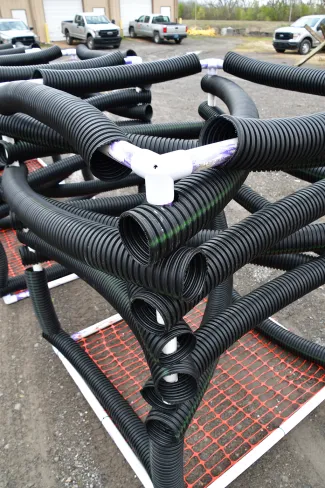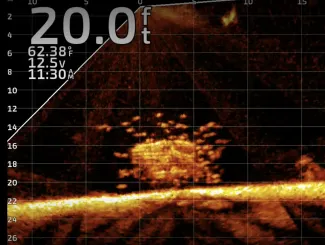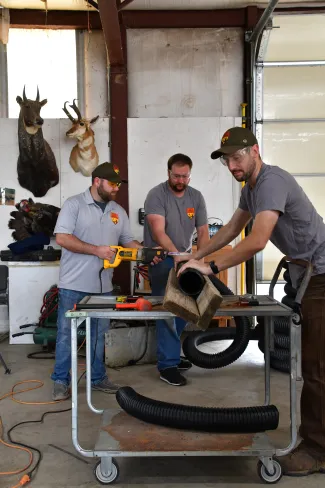New Fish Habitat Initiative Underway in Oklahoma; Anglers Invited to Contribute
The Wildlife Department is partnering with anglers to fund the construction of dozens of new-to-Oklahoma fish attractor structures that offer serious advantages over previous designs.
By adding the new $5, $10 or $25 “fish habitat donation” option to their Go Outdoors cart, anglers can supply funds to the initiative that is now at work installing the new habitat sites in lakes across the state. Anglers have already started contributing!
Background
Fish attractor sites have long been an important part of fish habitat management for the Wildlife Department. Historically, though, manmade fish attractor sites in our lakes have been comprised of brush piles, cedar trees, pallet structures, or artificial habitats like spider blocks made of rubber hoses and concrete. All of these things are particularly prone to deterioration or displacement, and usually within a matter of about three to five years. At that point, such habitat structures provide little, if any, benefit to fish or the anglers looking to catch them. Plus, they require time and money to replace frequently. The costs add up for fisheries managers.
Put simply, a better, longer-term fish attracting solution would be a heavy advantage for fisheries managers, anglers and fish.
Enter the “Shelbyville cube,” named after the Shelbyville, Ill. Lake Habitat Alliance who developed it.
A Better Solution to Habitat Enhancement
The Shelbyville cube is a game changing artificial fish attractor. And by bringing it to Oklahoma lakes, biologists are confident they’ve found a great option with a host of new benefits.

David Bogner and Brad Johnston, both fisheries personnel for the Wildlife Department, attended a habitat conference last year hosted by the Shelbyville Lake Habitat Alliance and a local Friends of Reservoirs group. It was there that they were introduced to the large structures and had the opportunity to help build several. The Alliance has already installed about 1,600 cubes into Illinois reservoirs comparable to Oklahoma lakes, perfecting the design and build process along the way.
The cubes are about 4’ long by 4’ wide and around 5’ tall, constructed of piping that is then wrapped in corrugated tubing and then anchored to the lake bottom. A “floor” constructed of snow fencing prevents sinking, siltation and other displacement issues that plague Oklahoma’s current artificial fish structure designs.
It didn’t take long for Bogner and Johnston to realize they needed to bring the Shelbyville cube design to Oklahoma lakes.
“With this ‘Shelbyville cube’ design, fish can find cover in and between the corrugated tubing while the PVC pipe keeps the tubing suspended in the water column,” Bogner said.
Built to Last
Michael Hollie, southeast region fisheries biologist who has since jumped on board the team of personnel leading the charge to propose, build and install the cubes across Oklahoma, said the lifespan of the Shelbyville cube is one of its best attributes.
“The size, coverage and durability of these structures is ideal,” Hollie said. “The best thing about them is they’ll last a lot longer. And by lasting longer, we’re talking 12-15 years or more of use!”

Twelve to fifteen years. Such cost efficiency far outlasts natural woody brush piles and spider blocks, and is a cost-effective option compared to comparable artificial options; not to mention the amount of cover they provide for fish.
Equally important, the cubes attract serious usage from fish. That’s a win for anglers hoping to get into some good fishing!
Off to a Great Start
To kick things off, the Wildlife Department recently purchased enough supplies for an initial buildout of 10 cubes, which have already been installed at Ft. Gibson Lake. In late April, about a week after installation, live sonar was showing crappie stacking up in the cover provided by the structures near Sequoyah State Park.

"I expected there to be some fish on the cubes, but I was pleasantly surprised at how many crappie there were,” said Jonathan West, another ODWC biologist who has been part of the habitat cube effort since it was first proposed by Bogner and Johnston. “These things are proving to be magnets for crappie, which means better crappie fishing!”
Those first 10 cubes were built at the ODWC’s Porter office, with several fisheries personnel learning the process of building and transporting the large cubes. While each cube costs about $250 to build, Bogner said the team could probably build them for even less if they can purchase supplies in bulk.
That’s where Oklahoma sportsmen and women come in to make it all happen.

How It Works
By adding a $5, $10 or $25 fisheries habitat donation to their Go Outdoors cart, anglers can supply funds that can then be matched three to one with federal Sportfish Restoration dollars. These are funds provided by the U.S. Fish and Wildlife Service to state wildlife agencies for things like fish habitat projects. The funds are derived from federal excise taxes paid by sporting goods manufacturers (who ultimately pass those costs on to anglers who buy their gear), that are then distributed by the USFWS to the states based on their size and number of licensed anglers.
Where It’s Headed & How Anglers Can Take Ownership
To break it down in an example, all this matching math means that $10,000 raised by anglers turns into $40,000. With bulk pricing of materials, that’s the amount of cash it would take to allow the ODWC and anglers to partner up and build about 200 Shelbyville cubes for distribution across Oklahoma.
“Hopefully, if we can exceed that, maybe we can do even more” Hollie said.
For the first year, that initial $10,000 in the example above is the goal. By making a small donation, anglers along with the fish that use the structures become the direct beneficiaries of that investment.
“We hope anglers and other sportsmen will get behind this project,” Bogner said. This is a solution not only for refurbishing old fish attractor sites, but also for installing a number of new sites. We can do it with anglers’ help.”
Once installed, habitat cube locations and coordinates will be added to the Wildlife Department’s fish attractors map, which means better fishing for those anglers keeping tabs on ODWC-installed fish structure.
To contribute a $5, $10 or $25 donation, go to gooutdoorsoklahoma.com and scroll down to “Donation to Fish Habitat Projects,” or simply select a donation option below to be directly routed. While you’re at it, go ahead and login and get your fishing license. It’s time to be out there fishing!
- ODWC contributors to this article include Michael Bergin, senior communication specialist; Brad Johnston, northeast region fisheries supervisor; and fisheries biologists David Bogner, Jonathan West, and Michael Hollie.